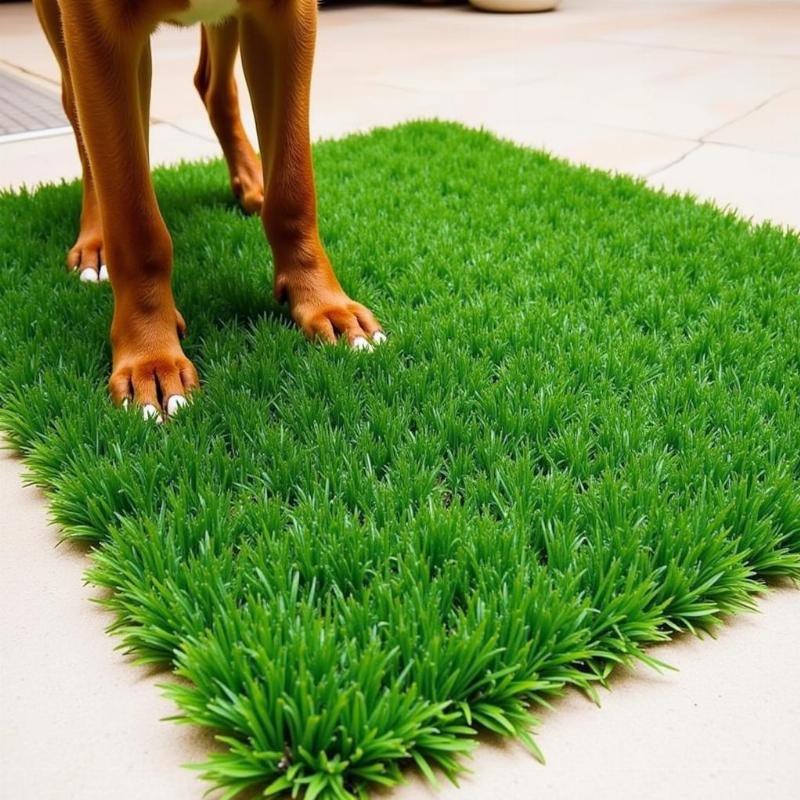Synthetic grass, often referred to as artificial turf, has become a popular choice for dog owners in the US seeking a low-maintenance, hygienic potty solution. It offers a convenient alternative to natural grass, especially for those living in apartments, condos, or areas with limited outdoor space. But is it the right choice for your furry friend? This comprehensive guide dives deep into the pros and cons of synthetic grass for dogs, helping you make an informed decision.
Benefits of Using Synthetic Grass for Dogs Potty
Synthetic grass eliminates many of the common headaches associated with natural grass dog potty areas. Say goodbye to muddy paws tracking dirt into your home! Artificial turf provides a consistently clean surface, reducing the risk of your dog picking up parasites or bacteria from the soil. Furthermore, it requires minimal upkeep, no mowing, fertilizing, or watering, freeing up your time and saving you money on lawn care.  Clean Paws on Synthetic Grass
Clean Paws on Synthetic Grass
Durability and Longevity of Artificial Turf
One of the most significant advantages of synthetic grass is its remarkable durability. Designed to withstand heavy foot traffic and the wear and tear of playful paws, it remains resilient for years. This makes it a cost-effective solution in the long run, compared to the ongoing expenses of maintaining natural grass. Additionally, high-quality synthetic grass is resistant to UV rays, ensuring it maintains its vibrant green color even under the intense American sun.
Choosing the Right Synthetic Grass for Your Dog
Not all synthetic grass is created equal. When choosing artificial turf for your dog’s potty area, consider factors like drainage, antimicrobial properties, and blade length. Opt for a product specifically designed for pets, featuring excellent drainage to prevent odor buildup and bacterial growth. Look for antimicrobial infill options that further enhance hygiene.
Installation and Maintenance of Synthetic Grass
Proper installation is crucial for optimal drainage and longevity. While some homeowners choose DIY installation, professional installation is often recommended for best results. Regular cleaning is essential to maintain hygiene and prevent odor. Rinsing the area with water and using a pet-safe cleaner designed for artificial turf will keep it fresh and clean.
Addressing Common Concerns About Synthetic Grass for Dogs
Some dog owners express concerns about the safety and environmental impact of synthetic grass. However, modern artificial turf is manufactured using non-toxic materials, making it safe for pets and children. Moreover, it conserves water and eliminates the need for chemical fertilizers and pesticides, contributing to a more eco-friendly environment. lawn treatment safe for dogs
Heat Retention in Synthetic Grass
One potential drawback of synthetic grass is its tendency to retain heat, especially in direct sunlight. Choose lighter-colored turf and consider installing it in a shaded area to mitigate this issue. Regular rinsing with water can also help cool down the surface on hot days. grass pee pad for large dogs
Is Synthetic Grass Right for Your Dog?
Synthetic grass offers a convenient and hygienic potty solution for dogs, but it’s essential to weigh the pros and cons before making a decision. Consider your dog’s individual needs, your lifestyle, and your budget. If you’re looking for a low-maintenance, clean, and durable alternative to natural grass, synthetic turf might be the perfect choice for you and your furry companion. pee pad holders for dogs
Expert Insights
Dr. Emily Carter, a renowned veterinarian in Los Angeles, shares, “Synthetic grass can be an excellent option for dog owners, especially in urban environments. It offers a clean and convenient potty solution, reducing the risk of exposure to parasites and bacteria.” She adds, “Choosing a high-quality product with proper drainage is crucial for maintaining hygiene and preventing odor buildup.”
John Miller, a professional dog trainer based in New York, states, “Many of my clients have switched to synthetic grass for their dogs’ potty areas and have been very pleased with the results. It’s a great way to create a designated potty spot, especially for apartment dwellers.”
Conclusion
Synthetic grass for dogs potty provides a practical and hygienic solution for pet owners seeking a low-maintenance alternative to natural grass. Its durability, cleanliness, and ease of maintenance make it an attractive option. While heat retention can be a concern, choosing the right product and implementing appropriate measures can mitigate this issue. By carefully considering the factors discussed in this guide, you can determine if synthetic grass is the right choice for your furry friend and your lifestyle. dog poop on artificial grass
FAQ
- How do I clean dog poop from synthetic grass? Simply scoop the solid waste and rinse the area with water.
- Is synthetic grass safe for puppies? Yes, modern synthetic grass is manufactured using non-toxic materials, making it safe for puppies.
- Does synthetic grass smell bad? With proper drainage and regular cleaning, synthetic grass should not smell bad.
- How long does synthetic grass last? High-quality synthetic grass can last for 10-15 years or more.
- Can I install synthetic grass myself? While DIY installation is possible, professional installation is recommended for optimal results.
- What is the best type of infill for synthetic grass for dogs? Antimicrobial infill is a good choice for enhancing hygiene.
- Is synthetic grass environmentally friendly? It conserves water and eliminates the need for chemical lawn treatments. what deters dogs from pooping on lawn
Beautdogs.us is your leading resource for all things dog-related in the US. We offer expert advice on dog breeds, care, and lifestyle, empowering you to provide the best possible life for your canine companion. Whether you’re a new dog owner or a seasoned expert, Beautdogs.us is your trusted source for comprehensive and engaging information. Contact us today for personalized guidance and support! Email: [email protected], Phone: +1 501-555-7529.